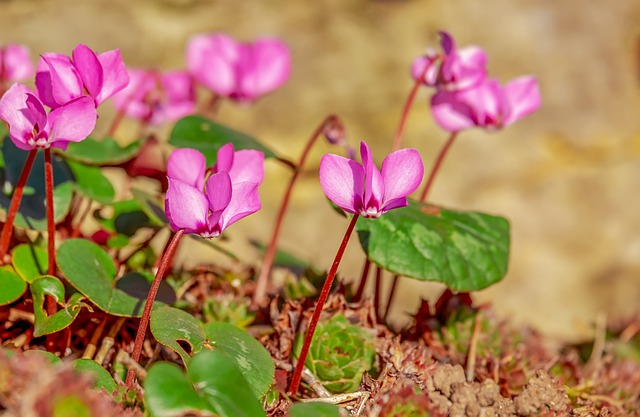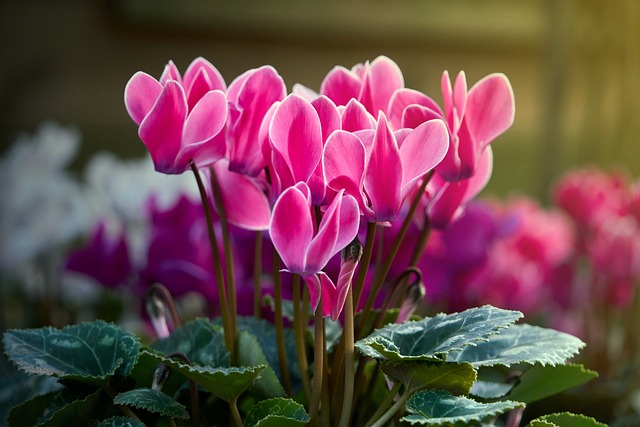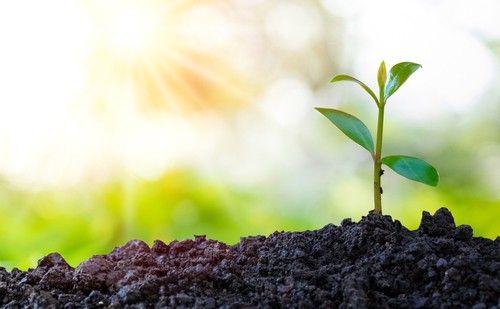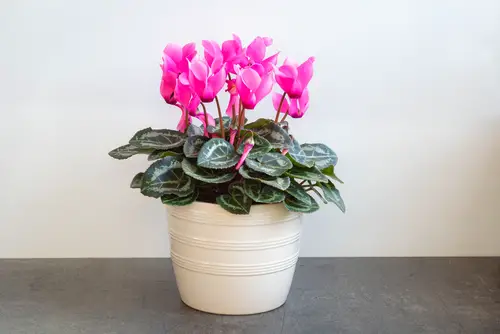Cyclamen plants are a popular choice for indoor gardening enthusiasts, but yellowing leaves can be a common issue that plant owners face. While it can be concerning to see leaves turn yellow, it is not always a sign of a serious problem.
Understanding the reasons why cyclamen leaves turn yellow can help you identify the issue and take the appropriate action. Several factors can contribute to Cyclamen Leaves Turning Yellow.
These factors include light and temperature, watering issues, nutritional deficiencies, pests and diseases, and the plant’s dormancy period. By learning about these factors, you can take steps to prevent yellowing leaves and ensure that your cyclamen plant stays healthy and vibrant.
Key Takeaways
- Yellowing leaves on cyclamen plants can be caused by a variety of factors, including light and temperature, watering issues, and nutritional deficiencies.
- Pests and diseases can also contribute to yellowing leaves on cyclamen plants.
- Understanding the reasons why cyclamen leaves turn yellow can help you take the appropriate action to prevent yellowing leaves and keep your plant healthy.
Also don’t miss:
- Why Are My Cantaloupe Leaves Turning Yellow?
- Why Are My Calathea Leaves Turning Yellow?
- Why Are My Bonsai Leaves Turning Yellow?
Understanding Cyclamen Plants

Cyclamen plants are a popular choice for indoor and outdoor gardening. These plants are native to the Mediterranean region and are known for their beautiful, colorful flowers and unique foliage. Cyclamen plants come in many different varieties, including the popular indoor cyclamen (Cyclamen persicum).
Cyclamen plants are known for their tuberous roots, which store nutrients and help the plants survive during periods of dormancy. During the growing season, cyclamen plants produce beautiful flowers and lush foliage. However, as the growing season comes to an end, the leaves may begin to yellow and die off.
Indoor cyclamen plants are often grown as houseplants and require careful attention to thrive. These plants prefer cool temperatures and moderate humidity, making them ideal for indoor environments. However, indoor cyclamen plants can be sensitive to changes in temperature and humidity, which can cause the leaves to yellow and die off.
Outdoor cyclamen plants are often grown in garden beds or containers and require similar care to indoor cyclamen plants. These plants prefer cool temperatures and moderate humidity, making them ideal for outdoor environments in temperate regions.
Cyclamen Leaves Turning Yellow – 5 Common Problems
Cyclamen plants are known for their attractive foliage and beautiful flowers. However, if you notice that the leaves of your cyclamen plant are turning yellow, it could be a sign of an underlying problem. Here are some common reasons why cyclamen leaves turn yellow:
1. Dormancy
Yellowing leaves on cyclamen can be a natural part of their lifecycle. After flowering ends in spring and summer, the warm temperatures trigger dormancy, and the leaves will begin to yellow. It’s completely normal, and nothing to worry about. During dormancy, the plant conserves its energy and prepares for the next growing season.
2. Improper Watering
Improper watering can also cause yellow leaves on cyclamen plants. Overwatering or underwatering can both lead to yellowing leaves. Cyclamen plants prefer moderate moisture, so make sure to water them only when the top inch of soil feels dry to the touch. It’s also important to use well-draining soil to prevent waterlogging.
3. Temperature
Cyclamen plants prefer cooler temperatures and yellow leaves may be a sign of overheating. These flowers prefer daytime temperatures between 60 and 65 degrees Fahrenheit, and a night-time temperature of about 50 degrees Fahrenheit. These cooler temperatures will keep them in bloom for longer.
4. Insect Pests

Yellowing leaves can also be a sign of insect pests such as spider mites or thrips. These pests can suck the sap from the leaves, causing them to turn yellow and eventually die.
To prevent insect infestations, keep the plant in a well-ventilated area and avoid overcrowding. If you notice an infestation, use an insecticidal soap or neem oil to get rid of the pests.
5. Nutrient Deficiency
A lack of nutrients such as nitrogen, magnesium, or iron can also cause yellowing leaves on cyclamen plants. To prevent nutrient deficiencies, make sure to fertilize the plant regularly with a balanced fertilizer.
Role of Light and Temperature
Cyclamen plants prefer cool temperatures and indirect light, making them ideal for indoor environments. Direct sunlight can cause the leaves to yellow and dry out, while insufficient light can prevent the plant from producing flowers.
Temperature is also a critical factor in the health of cyclamen plants. High temperatures can cause the leaves to yellow and drop prematurely, while low temperatures can cause the plant to go into dormancy. Cyclamen plants thrive in temperatures between 50-70°F (10-21°C), making them perfect for cool, shaded areas of the home.
It is essential to keep cyclamen plants away from heating vents or radiators, as this can cause the plant to dry out and become stressed. Similarly, avoid placing the plant in drafty areas or near doors that open frequently.
To ensure that the plant receives sufficient light, place it near a window that receives indirect sunlight. If the light is too strong, consider using a sheer curtain or shade to filter the light. Alternatively, a fluorescent light can be used to supplement natural light and provide the plant with the necessary light energy to grow.
Watering Issues
Cyclamen plants are sensitive to their watering needs, and improper watering can lead to yellowing leaves. Overwatering can cause root rot, which prevents the plant from absorbing nutrients and water from the soil. On the other hand, underwatering can cause the soil to dry out, leading to wilted and yellowing leaves.
To prevent yellowing leaves due to watering issues, it is important to provide the plant with the right amount of water. Cyclamen plants prefer to be kept in moderately moist soil, with the soil surface feeling slightly dry to the touch. Watering should be done when the soil feels dry, but not completely dry.
It is important to avoid getting the foliage wet when watering, as this can lead to damp and soggy foliage. Wet foliage can cause fungal diseases, which can lead to yellowing leaves. When watering, aim to water the soil directly and avoid getting water on the leaves.
If the soil is too wet or too dry, adjust the watering schedule accordingly. If the soil is too wet, reduce watering frequency and allow the soil to dry out slightly before watering again. If the soil is too dry, increase watering frequency and ensure that the soil is moist but not waterlogged.
Proper watering can help prevent yellowing leaves and keep cyclamen plants healthy and thriving.
Nutritional Deficiencies

Yellowing leaves on cyclamen plants can also be caused by a lack of nutrients. Nutrient deficiencies, such as a lack of nitrogen, iron, or manganese, can weaken the plant and cause the leaves to turn yellow.
To prevent nutrient deficiencies, gardeners can use a balanced fertilizer specifically designed for houseplants. Cyclamen plants require a balanced fertilizer with equal parts nitrogen, phosphorus, and potassium. Using a fertilizer with too much nitrogen can cause the leaves to grow too quickly, which can lead to yellowing and weakening of the plant.
Iron is also an essential nutrient for cyclamen plants. A lack of iron can cause the leaves to turn yellow and weaken the plant. Gardeners can add iron sulfate to the soil to provide the plant with the necessary iron.
In addition to using fertilizers, gardeners can also ensure that the soil pH is within the correct range. Cyclamen plants prefer a slightly acidic soil with a pH between 6.0 and 6.5. If the soil pH is too high or too low, the plant may not be able to absorb the necessary nutrients, which can lead to yellowing leaves.
Pests and Diseases
Yellowing cyclamen leaves can also be caused by pests and diseases. Insect pests like spider mites, cyclamen mites, aphids, and mealybugs can infest the plant and cause damage to the leaves, flowers, and stems. These pests suck the sap from the plant, causing the leaves to turn yellow, wither, and fall off.
To prevent insect infestations, gardeners should keep their plants clean and free of debris, and avoid overwatering. They can also use insecticidal soap or neem oil to control the pests. However, it is important to follow the instructions carefully and avoid using too much, as this can harm the plant.
Cyclamen can also be affected by fungal infections like powdery mildew, which can cause a white powdery coating on the leaves and stems. This can lead to yellowing and wilting of the leaves.
To prevent powdery mildew, gardeners should avoid overcrowding their plants and ensure good air circulation. They can also use a fungicide to control the infection.
Bacterial soft rot and Fusarium wilt are other common cyclamen plant diseases that can cause the entire plant to rapidly turn yellow and die. These diseases are caused by bacteria and fungi that infect the plant through the roots.
To prevent these diseases, gardeners should buy corms from reputable sources and plant them in clean media. They should also avoid overwatering and ensure good drainage.
Cyclamen Dormancy Period

Cyclamen plants are known to have a dormant period, during which the plant goes through a natural rest period. This period is usually triggered by the change of seasons, particularly during summer and winter.
During summer dormancy, the plant’s leaves may start to yellow and eventually fall off. This is a natural process and should not be a cause for concern. The plant is simply conserving energy and preparing for the next growing season.
It is important to note that the length of the dormancy period varies depending on the plant’s environment. Cyclamen plants grown indoors may have a shorter dormancy period than those grown outdoors.
To ensure that the plant goes through a healthy dormancy period, it is important to provide the right conditions. Cyclamen plants prefer cool temperatures ranging from 50℉ to 70℉ during dormancy. The soil should be kept moderately moist, and the plant should be kept pest-free to prevent stress.
When the plant starts to go dormant, it is important to avoid watering it too much. Overwatering can lead to root rot, which can be fatal to the plant. Instead, water the plant sparingly and only when the soil is dry to the touch.
It is also important to note that not all cyclamen plants go dormant at the same time. Some may start to go dormant earlier than others depending on their environment. Gardeners should observe their plants closely and take note of any changes in their appearance.
How to Prevent Yellowing Leaves
To prevent yellowing leaves on cyclamen plants, there are several things that can be done. Here are some tips:
- Proper watering: Cyclamen likes a moderately moist soil. It should be moist to touch, but never soggy. Water around the sides of the pot or from the bottom to prevent rot. Drain for 20 minutes and then discard the excess water. Overwatering can cause root rot and yellowing leaves.
- Temperature: Cyclamens prefer cooler temperatures and yellow leaves may be a sign of overheating. These flowers prefer daytime temperatures between 60 and 65 degrees Fahrenheit, and a night-time temperature of about 10 degrees. These cooler temperatures will keep them in bloom for longer.
- Light: Cyclamen plants like bright, indirect light. Too much direct sunlight can cause the leaves to yellow. If the plant is not getting enough light, it can also cause yellowing leaves. Make sure to place the plant in a spot with sufficient light.
- Fertilization: Over-fertilization can cause yellowing leaves on cyclamen plants. Use a balanced fertilizer once a month during the growing season. Avoid fertilizing during dormancy.
- Insect pests: Insect pests like spider mites and thrips can cause yellowing leaves. Check the leaves for any signs of pests and treat them accordingly.
- Dormancy: Yellowing leaves on cyclamen can be a natural part of their lifecycle. After flowering ends in spring and summer, the warm temperatures trigger dormancy, and the leaves will begin to yellow. It’s completely normal, and nothing to worry about.
Caring for Your Cyclamen Plant

Cyclamen care is crucial for the health and growth of your plant. When it comes to caring for your cyclamen plant, there are a few things you should keep in mind.
Firstly, make sure to grow your cyclamen in a cool location with plenty of bright, indirect sunlight. The ideal temperature range for cyclamen is between 50°F and 70°F. If the temperature gets too high, it can cause the leaves to turn yellow and the plant to go into dormancy.
Secondly, avoid overwatering your cyclamen. Overwatering can lead to root rot and cause the leaves to turn yellow. Instead, water your cyclamen when the top inch of soil is dry to the touch. It’s also important to use well-draining potting soil to prevent waterlogging.
Thirdly, keep your cyclamen in a pot that is just the right size. If the pot is too small, it can restrict the growth of the plant and cause the leaves to turn yellow. On the other hand, if the pot is too large, it can lead to overwatering and root rot.
Fourthly, remove any dead or damaged flower stems and leaves to promote new growth and keep your plant healthy. You can also fertilize your cyclamen every two weeks during the growing season to encourage healthy growth.
Lastly, cyclamen plants thrive in humid environments. You can increase humidity levels by placing a tray of water near the plant or by using a humidifier.
Frequently Asked Questions
When should I remove yellow leaves from my cyclamen?
Yellow leaves on cyclamen can be a natural part of their lifecycle, especially during dormancy periods. However, if the yellowing leaves are wilted or brown, it may be a sign of a problem. It is recommended to remove yellow leaves as soon as possible to prevent any further damage to the plant.
What causes yellow leaves on cyclamen in the winter?
Cyclamen plants prefer cooler temperatures and can suffer from stress when exposed to high heat. In the winter, indoor heating can cause the air to become too dry, which can lead to yellowing leaves. Overwatering can also lead to yellowing leaves in the winter.
What are some common indoor problems with cyclamen?
Common indoor problems with cyclamen include overwatering, underwatering, insufficient light, and exposure to high heat. These problems can cause yellowing leaves, drooping leaves, and a lack of blooms.
Why are my cyclamen leaves drooping and turning yellow?
Drooping and yellowing leaves can be a sign of overwatering or underwatering. Cyclamen plants prefer moderate moisture, and it is important to allow the soil to dry out slightly between waterings. Overwatering can cause root rot, which can lead to drooping and yellowing leaves.
What causes cyclamen leaves to curl?
Curling leaves on cyclamen can be caused by a lack of moisture or exposure to high heat. It is important to keep the soil moist but not waterlogged and to avoid exposing the plant to temperatures above 68 degrees Fahrenheit.
Why is my potted cyclamen experiencing yellowing leaves?
Yellowing leaves on potted cyclamen can be caused by a variety of factors, including overwatering, underwatering, exposure to high heat, and insufficient light. It is important to provide the plant with the proper environment and care to prevent yellowing leaves.

Hey, I’m Lisa and I’ve been an avid gardener for over 30 years. I love writing, talking and living in the garden! Feel free to connect with me on my socials below


